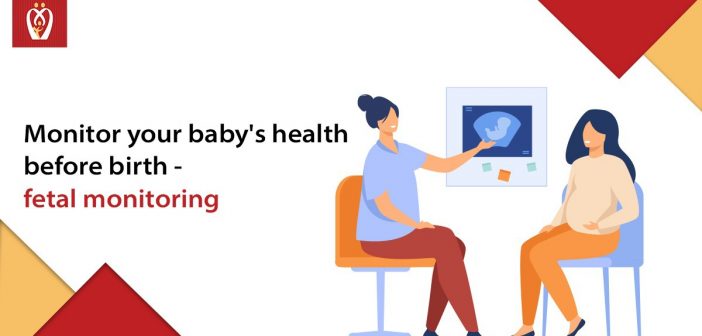Introduction
Fetal monitoring is a method of checking your baby’s (fetus) heart rate during childbirth. Your baby’s heart rate is a strong indicator of how well they are doing. It can reveal whether or not there is an issue. Monitoring can occur at any moment during labour (continuous) or at predetermined intervals (intermittent). The majority of women are monitored in some way. During your pregnancy, discuss your options with your GP or nurse-midwife.
If you have a low-risk pregnancy, which means you and your baby have no known concerns, you can request intermittent monitoring ahead of time. However, if a problem arises during labor, your baby’s heart rate may need to be monitored continuously. Your birth wishes can be written down in your birth plan. This is a list of things you’d like to know while you’re in labor. One of which is fetal monitoring during labor.
How is fetal monitoring done during labor?
There are two types of monitoring done: internal (on the inside of the body) and external (on the outside of the body). It’s external for the majority of women. External monitoring might be done regularly or on a sporadic basis. For example, the nurse or doctor uses a handheld instrument to listen to your baby’s heart through your tummy with intermittent monitoring.
The nurse or doctor sometimes uses a customised stethoscope. During labour, the heart rate is measured at regular intervals. For example, during the early stage of labour, the baby’s heartbeat might be monitored every 30 minutes in a healthy pregnancy. During the second step, it would be tested every 15 minutes.
A woman who has a problem during pregnancy, but is not at high risk, will have her heartbeat monitored more frequently. You may be permitted to go around if your baby’s heartbeat is not being monitored. Your baby’s heartbeat is constantly monitored via continuous monitoring. Two flat devices (called sensors) are held on your abdomen by elastic bands.
The heart rate of the baby is recorded by one sensor. The other displays the duration of your contractions. You must remain close to the monitor next to your bed. You can sit in a chair or stand near the monitor if you get out of bed. However, you are unable to walk or bathe.
The heartbeat of a baby can sometimes be checked without the use of wires. You would be able to walk around during labour if you used this strategy. However, it isn’t available everywhere. Also, if you go too far away or if the device slips off while you’re walking, it might not operate. Internal monitoring is only carried out in specific circumstances during childbirth. The sensor’s small wire is passed through your vaginal and cervix and into your uterus. Then, it’s affixed to your child’s head.
When to go for fetal monitoring?
In a low-risk pregnancy, intermittent monitoring may be an option. The term “low-risk” refers to that you and your baby have no known health issues and that your pregnancy has gone smoothly. In a high-risk pregnancy, doctors recommend continuous monitoring during delivery. If you have preeclampsia or type 1 diabetes, you are at high risk if your baby has a health condition.
When an issue arises during childbirth, pregnancy can become high risk. The baby’s heartbeat would then be monitored at all times. If you opt for epidural pain treatment, you will be monitored throughout your labor.
Why go for fetal monitoring?
The most basic kind of prenatal monitoring is listening to the fetal heartbeat with handheld Doppler equipment. Counting the foetal heart rate is commonly done during prenatal checkups. During late pregnancy and labor, foetal monitoring may be used to detect issues in the infant. For example, it can reveal whether additional testing or a C-section are required.
Advantages of fetal monitoring during labor
Intermittent
- You aren’t always tethered to cables. So you may get out of bed and walk around while giving birth.
- It might convince you and your partner that the labor is moving along well.
- It might demonstrate to the doctor or nurse-midwife that labor can proceed at its speed.
Continuous
- It can immediately reveal an issue.
Risks associated with fetal monitoring
Intermittent
This type of surveillance is extremely safe. However, there’s a potential that an issue won’t be discovered soon.
Continuous
Unless you have wireless monitoring, you won’t be able to roam around as much.
If the baby’s heartbeat changes, it could indicate an issue when there isn’t. According to studies, monitoring has been associated with an increase in caesarean deliveries and the use of a vacuum or forceps during delivery. Monitoring does not result in a caesarean section. It does, however, display all of the variations in the baby’s heartbeat. Some of these changes would indicate a problem. However, some of these may not indicate a problem. A doctor must interpret those results.
Nurturey PinkBook- helps manage your child’s health before birth
With the Nurturey’s PinkBook, NHS library, ensure that you receive the most relevant and up-to-date information to assist you in your parenting journey. Get up-to-date information on immunizations, child growth & development, child health, pregnancy, and other health-related subjects for parents.
Nurturey PinkBook is the smartest digital upgrade for the NHS paper red book. It is intended for parents of young children as well as pregnant mothers. Nurturey’s smart tools help you feel comforted, informed, and confident as you walk through the journey of your child’s health and pregnancy.
Conclusion
Electronic fetal monitoring is a tool, and healthcare practitioners may improve their stewardship of it. Cesareans are being avoided by using established definitions to define aberrant cardiac patterns. Before electing a Cesarean, Category II tracings should be handled first with preventive measures and scalp stimulation.
Wireless, water-resistant continuous electronic monitors are currently available in some hospitals. Mobile monitors may allow moms to move about more during labor and give them the option of taking a shower to help them cope.




